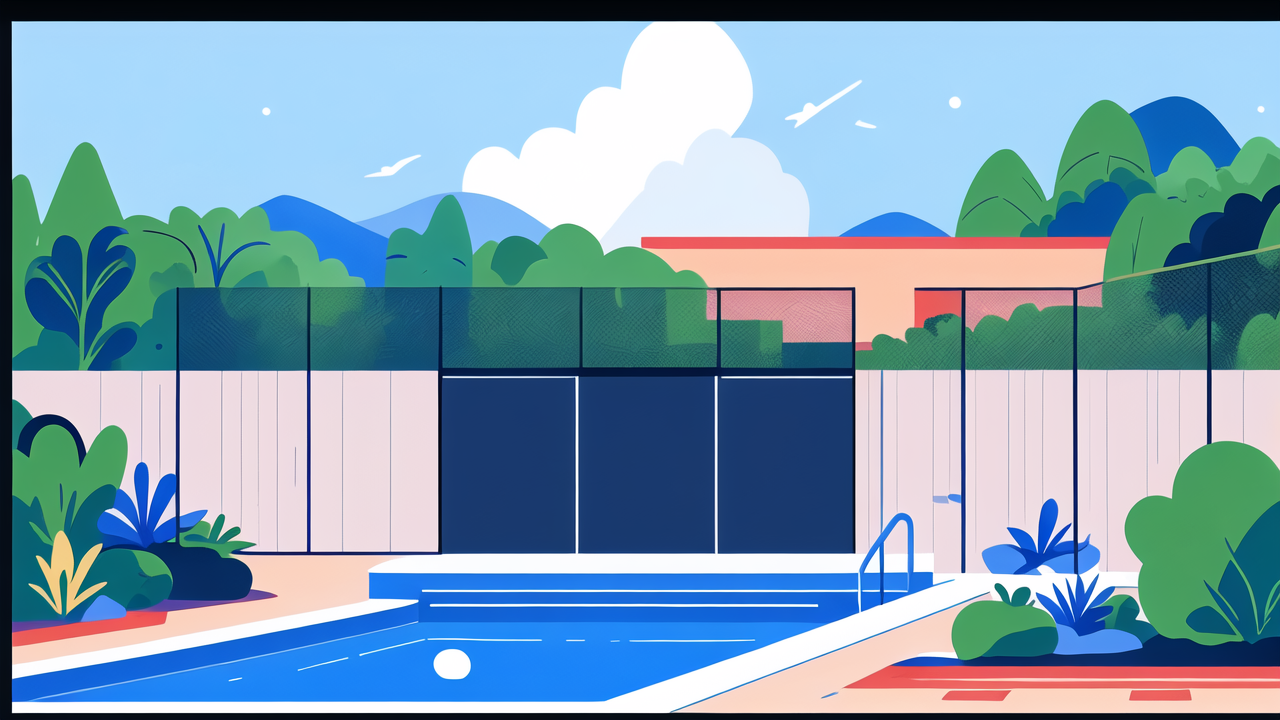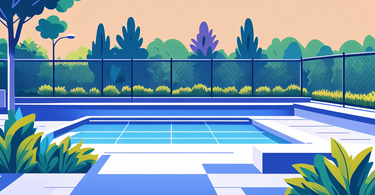Understanding Pool Privacy Fences: Types and Benefits
The Importance of Pool Privacy for Homeowners
Pool privacy is a top priority for many homeowners. It creates a personal oasis in your backyard. With a privacy fence, you can relax without feeling exposed. It shields you from prying eyes and nosy neighbors.

Privacy fences offer many benefits:
- They create a sense of seclusion
- They reduce noise from outside
- They enhance the safety of your pool area
- They can boost your property value
A well-designed fence turns your pool into a private retreat. It allows you to enjoy your outdoor space freely. You can sunbathe, swim, or entertain without worry. Privacy fences also help define your property boundaries.
Many homeowners find that increased privacy leads to more pool use. You're more likely to use your pool when you feel comfortable and secluded. This makes your investment in a pool more worthwhile.
Comparing Different Types of Pool Privacy Fences
There are several types of pool privacy fences to consider. Each has its own pros and cons:
- Wooden Fences:
- Classic look
- Affordable
- Can be painted or stained
- Requires regular maintenance
- Vinyl Fences:
- Low maintenance
- Durable and long-lasting
- Available in various styles
- More expensive than wood
- Aluminum Fences:
- Lightweight and strong
- Rust-resistant
- Minimal maintenance required
- Less privacy than solid options
- Composite Fences:
- Eco-friendly
- Looks like wood but more durable
- Low maintenance
- Can be pricey
- Glass Fences:
- Modern and sleek look
- Allows light to pass through
- Requires frequent cleaning
- Expensive option
Choose a fence type that fits your budget, style, and maintenance preferences. Consider factors like durability, aesthetics, and local climate when deciding.
Benefits of Installing a Pool Privacy Fence
Installing a pool privacy fence offers numerous advantages:
- Enhanced Privacy:
- Create a secluded swimming environment
- Enjoy your pool without feeling watched
- Improved Safety:
- Prevent unauthorized access to the pool area
- Keep children and pets safe
- Noise Reduction:
- Minimize outside noise for a peaceful atmosphere
- Reduce noise from your pool activities reaching neighbors
- Wind Protection:
- Shield your pool area from strong winds
- Reduce debris blowing into the pool
- Aesthetic Appeal:
- Enhance the overall look of your backyard
- Create a cohesive design with your landscaping
- Property Value:
- Increase your home's market value
- Make your property more attractive to potential buyers
- Legal Compliance:
- Meet local regulations for pool safety
- Avoid potential fines or legal issues
A well-chosen privacy fence can transform your pool area. It creates a luxurious and safe environment for you and your family to enjoy.
Key Considerations When Selecting a Pool Privacy Fence
Assessing Your Property for a Pool Privacy Fence
Before choosing a fence, carefully assess your property:

- Measure Your Space:
- Determine the length of fence needed
- Consider the shape of your pool area
- Evaluate the Terrain:
- Check for slopes or uneven ground
- Plan for any necessary grading
- Consider Existing Landscaping:
- Work around trees, shrubs, and garden beds
- Decide if any vegetation needs to be removed or relocated
- Assess Sunlight and Shade:
- Think about how the fence might affect natural light
- Plan for areas that need more or less sun exposure
- Identify Access Points:
- Plan for gates and entrances
- Ensure easy access for maintenance and emergencies
- Check Underground Utilities:
- Locate any buried pipes or cables
- Plan fence placement to avoid utility lines
Taking time to assess your property will help you choose the best fence. It ensures a smooth installation process and a result that fits your needs perfectly.
Understanding Zoning and Regulatory Requirements in the United States
Before installing a pool privacy fence, research local regulations:
- Height Restrictions:
- Most areas limit residential fences to 6-8 feet
- Front yard fences may have lower height limits
- Setback Rules:
- Fences may need to be set back from property lines
- Check specific rules for corner lots
- Material Restrictions:
- Some areas prohibit certain fence materials
- HOAs may have additional material guidelines
- Pool Safety Regulations:
- Ensure your fence meets local pool enclosure standards
- Check requirements for gate latches and locks
- Permit Requirements:
- Determine if you need a building permit
- Submit necessary paperwork before starting construction
- Neighborhood Guidelines:
- Review any homeowners association rules
- Consider the visual impact on your neighbors
Consult your local building department or a fencing professional. They can guide you through the regulations. Compliance is crucial to avoid legal issues or fines down the road.
Selecting Materials and Design for Durability and Aesthetics
Choose materials and design that balance durability and visual appeal:
- Climate Considerations:
- Select materials that withstand your local weather
- Consider UV resistance for sunny areas
- Maintenance Requirements:
- Assess how much upkeep you're willing to do
- Choose low-maintenance options if you prefer less work
- Lifespan and Durability:
- Compare the expected lifespan of different materials
- Consider long-term cost-effectiveness
- Style Compatibility:
- Choose a design that complements your home's architecture
- Consider the overall aesthetic of your outdoor space
- Color and Finish Options:
- Select colors that enhance your pool area
- Consider how the finish will age over time
- Texture and Visual Interest:
- Decide between smooth or textured surfaces
- Consider adding decorative elements for visual appeal
Remember, your fence is both functional and decorative. It should provide privacy while enhancing your outdoor living space. Choose materials and designs that you'll love for years to come.
Best Practices and Innovative Solutions for Pool Privacy Fences
Innovative Design Ideas to Enhance Your Pool's Privacy
Consider these creative ideas to make your pool privacy fence stand out:

- Living Walls:
- Incorporate plants for a natural, green barrier
- Use climbing vines or hanging plants for added texture
- Mixed Materials:
- Combine wood, metal, and glass for a unique look
- Create visual interest with contrasting textures
- Horizontal Slats:
- Modern alternative to traditional vertical designs
- Allows for partial visibility while maintaining privacy
- Decorative Panels:
- Use laser-cut metal or wood panels for artistic flair
- Create custom patterns that reflect your personal style
- Tiered or Curved Designs:
- Break up straight lines with curved fence sections
- Use varying heights to add visual interest
- Integrated Lighting:
- Install LED strips or solar-powered lights
- Create ambiance for nighttime swimming
These innovative ideas can transform a simple fence into a stunning feature. They add personality and style to your pool area while maintaining privacy.
Maintaining and Caring for Your Pool Privacy Fence
Proper maintenance ensures your fence stays beautiful and functional:
- Regular Cleaning:
- Remove dirt and debris with appropriate cleaning methods
- Use a power washer for deep cleaning when needed
- Annual Inspections:
- Check for damage, loose parts, or signs of wear
- Look for signs of rust, rot, or pest infestation
- Prompt Repairs:
- Fix small issues before they become major problems
- Replace damaged boards or panels as needed
- Refinishing:
- Apply sealants or paint to protect wooden fences
- Touch up paint on metal fences to prevent rust
- Trimming Nearby Plants:
- Keep plants from growing into or damaging the fence
- Trim overhanging branches that could fall on the fence
- Winterizing:
- Take necessary steps to protect your fence in cold climates
- Remove snow buildup to prevent structural damage
Following these maintenance tips will extend the life of your pool privacy fence. Regular care keeps your fence looking great and functioning well for years to come.
Overcoming Common Challenges in Pool Privacy Fence Installation
Be prepared to face these common challenges during installation:
- Uneven Terrain:
- Use adjustable fence panels for sloped areas
- Consider terracing for significant grade changes
- Underground Obstacles:
- Conduct a thorough survey before digging
- Be prepared to adjust post locations if needed
- Proper Post Installation:
- Ensure posts are set deep enough for stability
- Use concrete footings in areas with loose soil
- Gate Alignment:
- Take extra care to ensure gates are level and properly aligned
- Use high-quality hardware for smooth operation
- Material Expansion:
- Allow for natural expansion and contraction of materials
- Follow manufacturer guidelines for proper spacing
- Professional Help:
- Know when to call in experts for complex installations
- Consider hiring professionals for tasks beyond your skill level
With proper planning and preparation, you can overcome these challenges. Don't hesitate to seek expert advice when needed. A well-installed fence will provide years of privacy and enjoyment.
